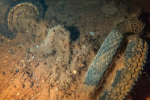The steel steamship St Fergus was launched from the Leith yard of Hawthorn Leslie and Co Ltd (Yard No 134) on 19th June 1913. She measured 150.0′ x 24.1′ x 10.0′ and her tonnage was 390 gross tons, 144 net tons. She was powered be a triple expansion steam engine by Hawthorn Leslie delivering 58 registered horse power.
Owned by the Aberdeen, Leith and Clyde Steamship Co Ltd., Aberdeen she operated primarily on the east coast and northern island routes.
She survived the dangers of World War One continuing to ply back and forth throughout the conflict to return to peacetime duties at the conclusion of hostilities. Again, in 1939, with the outbreak of World War Two, the St Fergus faced the dangers of attack from German U-boats and bombers as she delivered much needed wartime supplies to the communities of East Scotland, Orkney and Shetland. On 29th November 1940 she survived an attack by a German aircraft unscathed. Ironically she was to be lost only weeks later in a collision with another merchant ship.
On 31st December 1940 she was en route from Aberdeen to Stromness with a general cargo under the command of Captain Wilfred Thomas Toman. Meanwhile the larger steamship Fidra (1574 gross tons, 265.0′ x 40.5′ x 16.3′ ) owned by the Scottish Navigation Co Ltd of Glasgow was approaching the same position off Rattray Head. The details of the subsequent collision are not recorded but it would appear that, in the darkness around 10:40pm that night, the two ships collided with the smaller St Fergus suffering severe damage. Indeed, Captain Toman was lost in the incident, perhaps killed in the initial impact. The remainder of the crew appear to have survived most likely transferring to the Fidra before the St Fergus sank.
The wreck in position 57° 37.422’N, 001° 38.018’W has not been absolutely confirmed as the St Fergus but the location, dimensions/layout and the damage visible on the wreck would strongly imply this is indeed St Fergus. She lies in 75 metres with a least depth clearance of 6 metres. Buchan Divers who explored the wreck in 2020 and again in 2021 report a medium sized rear engined steamship with a small triple expansion engine. She sits upright on the seabed with the stern section more or less in tact but the forward section severely damaged, broken and sinking into the seabed. This would be consistent with collision damage from the larger vessel.
We would like to acknowledge the assistance of Buchan Divers – www.buchandivers.com in the preparation of this article. We would also like to thank Naomi Watson for allowing us to reproduce her underwater photographs of the wreck.


































